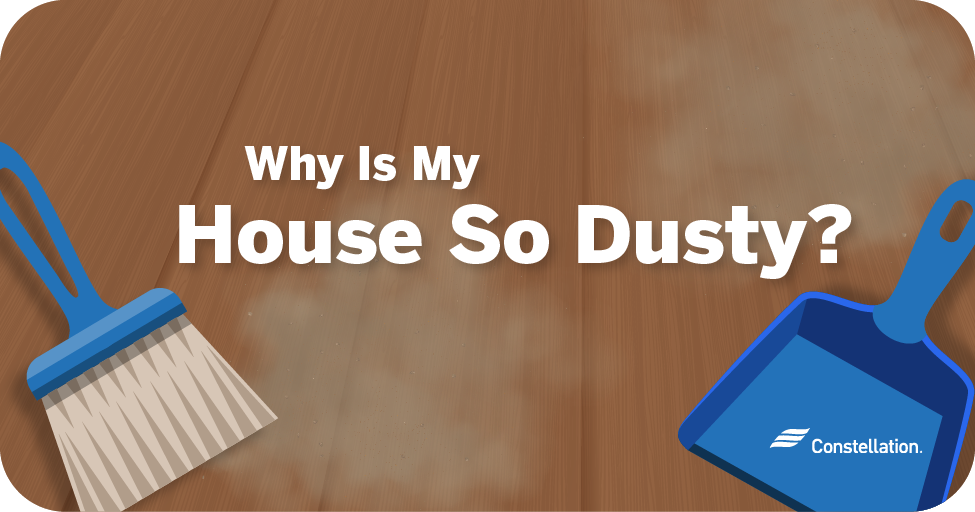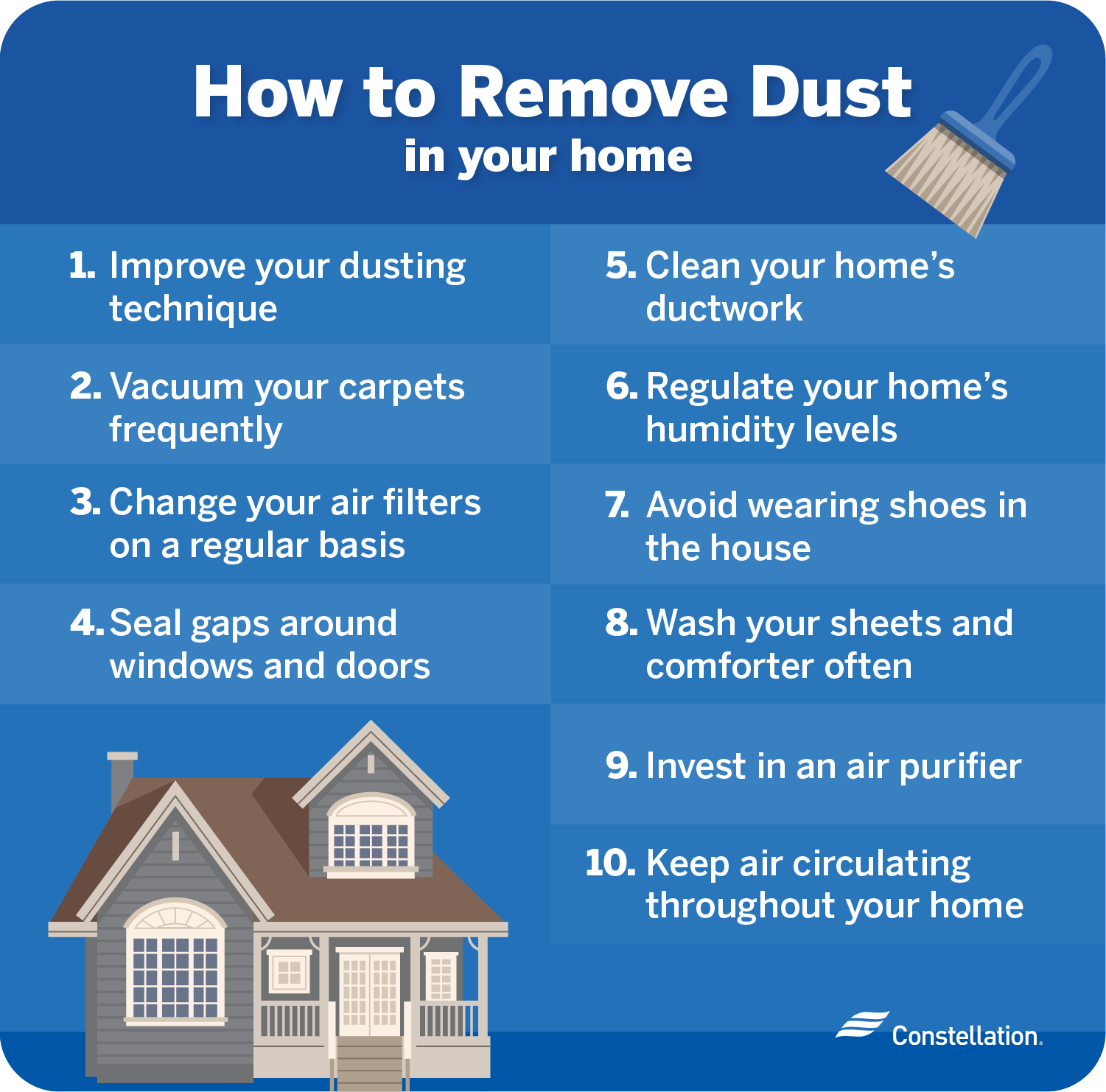
- Category:
Home Energy Savings - Published:
February 11, 2022
Why Is My House So Dusty?
If you’re asking yourself, why is my house so dusty, you are in the right place to find answers–and discover how to get rid of dust in your house. Dust is a general term for hundreds of types of tiny particles that can land on surfaces around your home. And because there are hundreds of types of dust particles, you can count a nearly equal number of sources and what causes dust. We’ll tackle the big ones so that you can take control of excessive dust in your house for a cleaner, healthier home.
What is dust and how does it form?
Just what is dust made of? The answer is simple: It’s complicated. Most dust, about two-thirds of it, comes from airborne particles that enter from outside your home. These are things like pollen and dirt in the air, according to experts. The rest comes from inside sources.
A pet, a sweater or a rug can shed particles. You yourself also contribute to dust when you shed dead skin and hair. Microscopic insects feed on dust, adding their feces, exoskeletons, and dead bodies to the icky mix. Cooking can send sticky particles into the air, especially if you burn something.
12 causes of dust buildup
Before you can fix the problem of excessive dust in your house, you will need to discover what causes the dust in your home in the first place. Right after asking, why is my house so dusty, you need to ask yourself: Where is the dust coming from?
- Pollen. Perhaps your house is surrounded by trees and plants well-known for pollen production. Check local weather conditions for up-to-date pollen reports.
- Pet dander. Pet hair particles and skin mixed with saliva and urine combine to form these allergy-inducing particles.
- Human skin cells. We shed millions of dead skin cells every day, a significant component of dust.
- Clothing fibers. Clothing and textiles like bedding, drapery, rugs and wall coverings shed tiny fibers.
- Household products. Any aerosol products and sprays or powders create tiny airborne particles that settle around your home.
- Smoke. Smoke from outside or from burning that bag of microwave popcorn adds to particulate matter inside. Frying sends tiny grease balls into the air, adding to the mix.
- Humidity and mold. The two go together. Excessive moisture in the air creates the ideal environment for mold and its spores.
- Insects. They shed body parts. Their dead bodies desicate. Their feces and vomit spreads. It all adds up to a gross-factor within household dust.
- Dirt. You might track in dirt from the outside and dirt can seep in around windows, through vents, and into various cracks and crevices.
- Pollution. The bus going by your house spewing diesel, the backhoes digging a foundation down the road, the factory across town–they all send particulates into the air.
- Cleaning. You might be trying to get dirt out, but the act of cleaning can actually stir up particles and spread them around your house.
- HVAC system. If your heating and air conditioning are not clean, they can spew dust into every room.
10 tips to get rid of dust in your home

Once you determine what causes dust in your house, you’re ready to put together a program to get rid of dust. You can control excessive dust in your house with these tips.
1. Improve your dusting technique
Don’t just spread dust around. A feather duster disturbs the dust on surfaces, sending it into the air, where it can resettle back where you just cleaned. A damp cloth and some of the charged wipes now being sold will capture dust as you clean. Using a dusting spray helps you not just move, but remove dust.
2. Vacuum your carpets frequently
Vacuuming frequently is one way to keep excessive dust in the house from increasing. Vacuuming carpets is especially worthwhile, as it removes loose fibers along with dust and dirt.
It’s important to do research before choosing a vacuum cleaner. Pay particular attention to filters and good seals on the suction system so that you aren’t picking up dust on one end and spewing it out the other.
3. Change your air filters on a regular basis
Regular HVAC maintenance is one method for how to prevent dust buildup. Clean and change your system’s air filters at least seasonally, more if you have pets or live in an area with high levels of airborne particles.
4. Seal gaps around windows and doors
Prevent dirt and pollution outside from making its way in. Take the time to find air leaks in your home. Sealing doors and windows will prevent dust particles and insects from entering your home. Plus, you will be better able to maintain a comfortable temperature inside.
5. Clean your home’s ductwork
Dust can build up in your HVAC system and ducts, even if you regularly change your filters. Cleaning air ducts will eliminate a source of dust and will improve overall air quality.
6. Regulate your home’s humidity levels
Too much humidity will multiply your dust problem. It promotes the growth of mold and spores, which can wreak havoc on your health. It also creates a nurturing environment for dust mites. Maintain an ideal home humidity level. Too low, and you’ll have dust problems due to dry skin. Too high, and you will have mold and mites.
You can get rid of moisture in the home by repairing water leaks and sealing damp basements. Energy efficient fans in damp bathrooms and attics will vent out unwanted moisture. An energy-efficient humidifier can be invaluable in regulating humidity.
7. Avoid wearing shoes in the house
A good way to keep outside dust from invading your home is to remove your shoes at the door. By not wearing street shoes in the house, you will cut down on dust and microbes on your floor, and will save wear and tear on carpets.
8. Wash your sheets and comforter often
Wash your bedding in hot water weekly, or bi-weekly at a minimum. Bedding traps skin particles and pet dander in its fibers, which feed dust mites. Loose fibers in bedding add to dust in your bedroom. Washing in hot water not only removes dust, it kills dust mites.
9. Invest in an air purifier
A certain amount of dust will remain airborne no matter what you do. If you value clean air or suffer from allergies, an energy-efficient air purifier will remove most dust particles and pollution.
10. Keep air circulating throughout your home
Use house fans to remove excess humidity, smoke and dust, and keep fresh air circulating throughout your residence.
The importance of keeping your home dust-free
Asking why my house is so dusty and then finding ways to get rid of dust is about more than having a clean and orderly home. Excessive dust in your house is a health hazard. Learning how to prevent dust buildup will make your home safe and comfortable.




